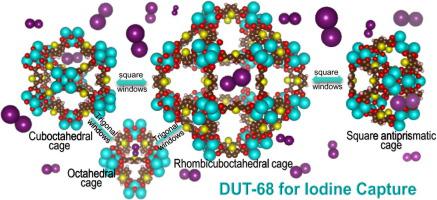Chemical Engineering Journal ( IF 13.3 ) Pub Date : 2021-05-31 , DOI: 10.1016/j.cej.2021.130578
Lingyu Wang , Teng Li , Xiuting Dong , Maobing Pang , Songtao Xiao , Wen Zhang

|
The effective capture of radioiodine is vital to the development of the nuclear industry and environmental protection. Metal-organic frameworks (MOFs) are promising adsorbents for iodine vapor due to the versatile metal nodes and linkers, as well as tunable pore structures. Here, five thiophene-based metal–organic frameworks with different pore geometries were investigated for their iodine adsorption properties, and the relationship between the pore structures and iodine adsorption capacities is examined. DUT-68 adsorbs a large amount of iodine (1081 mg/g), which is 28% higher than that of the homologous DUT-67 (843 mg/g), because its large cage could provide more space for the packing of molecular iodine in the middle of the pore. The MIL-53-TDC(In) with 1D straight-through pore channels only has an iodine capacity of 660 mg/g, due to its small pore volume and little confinement effect. Meanwhile, the In-DTC and Ho-DTC, with smaller pore sizes than the kinetic diameter of iodine molecules, exhibit almost no iodine adsorption properties. Raman, fluorescence, XPS spectra and DFT calculation confirm the strong charge transfer effect from thiophene linkers to trapped iodine. DFT calculation also provides quantitative adsorption energy of −44.5 kJ/mol between one iodine molecule and one thiophene group linked with Zr nodes, higher than that of thiophene groups linked with In nodes. This work may motivate the topology-directed design of MOFs for iodine capture with optimized pore structures, metal nodes and linkers to enhance the adsorption performance.
中文翻译:

用于碘捕获的基于噻吩的 MOF:孔结构和相互作用机制的影响
放射性碘的有效捕获对核工业的发展和环境保护至关重要。金属有机框架(MOF)由于具有多功能的金属节点和连接体以及可调节的孔结构,是很有前途的碘蒸气吸附剂。在这里,研究了五种具有不同孔几何形状的噻吩基金属有机骨架的碘吸附性能,并检查了孔结构与碘吸附容量之间的关系。DUT-68吸附大量碘(1081 mg/g),比同源DUT-67(843 mg/g)高28%,因为它的大笼子可以为分子碘的填充提供更多空间在毛孔中间。具有一维直通孔道的 MIL-53-TDC(In) 仅具有 660 mg/g 的碘容量,由于其孔体积小,限制效应小。同时,In-DTC 和 Ho-DTC 的孔径小于碘分子的动力学直径,几乎没有碘吸附特性。拉曼、荧光、XPS 光谱和 DFT 计算证实了从噻吩接头到捕获碘的强电荷转移效应。DFT 计算还提供了一个碘分子和一个与 Zr 节点连接的噻吩基团之间的定量吸附能 -44.5 kJ/mol,高于与 In 节点连接的噻吩基团。这项工作可能会推动拓扑导向设计用于碘捕获的 MOF,具有优化的孔结构、金属节点和连接器,以提高吸附性能。孔径小于碘分子的动力学直径,几乎没有碘吸附特性。拉曼、荧光、XPS 光谱和 DFT 计算证实了从噻吩接头到捕获碘的强电荷转移效应。DFT 计算还提供了一个碘分子和一个与 Zr 节点连接的噻吩基团之间的定量吸附能 -44.5 kJ/mol,高于与 In 节点连接的噻吩基团。这项工作可能会推动拓扑导向设计用于碘捕获的 MOF,具有优化的孔结构、金属节点和连接器,以提高吸附性能。孔径小于碘分子的动力学直径,几乎没有碘吸附特性。拉曼、荧光、XPS 光谱和 DFT 计算证实了从噻吩接头到捕获碘的强电荷转移效应。DFT 计算还提供了一个碘分子和一个与 Zr 节点连接的噻吩基团之间的定量吸附能 -44.5 kJ/mol,高于与 In 节点连接的噻吩基团。这项工作可能会推动拓扑导向设计用于碘捕获的 MOF,具有优化的孔结构、金属节点和连接器,以提高吸附性能。DFT 计算还提供了一个碘分子和一个与 Zr 节点连接的噻吩基团之间的定量吸附能 -44.5 kJ/mol,高于与 In 节点连接的噻吩基团。这项工作可能会推动拓扑导向设计用于碘捕获的 MOF,具有优化的孔结构、金属节点和连接器,以提高吸附性能。DFT 计算还提供了一个碘分子和一个与 Zr 节点连接的噻吩基团之间的定量吸附能 -44.5 kJ/mol,高于与 In 节点连接的噻吩基团。这项工作可能会推动拓扑导向设计用于碘捕获的 MOF,具有优化的孔结构、金属节点和连接器,以提高吸附性能。































 京公网安备 11010802027423号
京公网安备 11010802027423号